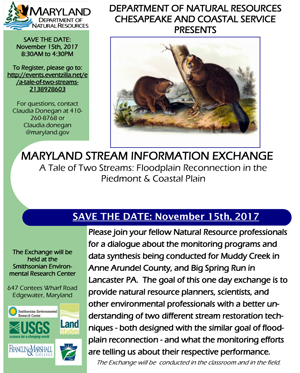The department has a long history of providing information to other professionals regarding stream functions, restoration science and techniques though our Maryland Stream Information Exchanges beginning in the late 1990's.
Stream restoration is a relatively young science and monitoring for ecological uplift of these projects have shown varied results. Much of this is due to the relatively young age of the stream restoration projects and the lack of consistency in monitoring methodologies. The main purpose of the information exchanges is to provide and share research, monitoring data and information regarding stream restoration between professionals; to learn what has been successful and what has not; and to facilitate discussions that will help to tailor restoration and monitoring methodologies for the future.
MARYLAND STREAM INFORMATION EXCHANGE: Regenerative Stream Conveyance (RSC) - November 14-15, 2018
Construction Training Agenda
National Arboretum, Washington, DC
Administrative Building
3501 New York Ave NE, Washington, DC 20002
The Chesapeake and Coastal Service in partnership with the Alliance for the Chesapeake Bay and private contractors conducted a two day training on a stream restoration practice called Regenerative Stream Conveyance (RSC). This training was geared for construction contractors who are interested in ecological restoration of streams. The training was also used as the release event for a Chesapeake and Coastal Service generated RSC Construction Guidance Document for contractors and designers. Regenerative Stream Conveyance is a stream restoration practice that aims to re-establish hydrologic conditions critical to reversing the degrading trend and resetting it into a regenerative mode. The goals of the Regenerative Stream Conveyance Construction Guidance document and training are to advance the successful application of Regenerative Stream Conveyance approach by:
- Introducing the science that guides stream restoration;
- Presenting conceptual information on constructing regenerative projects; and
- Providing guidance on construction practices and techniques for common RSC features.
Experienced as well as novice contractors benefited from a deeper understanding of the science and reasoning behind adapted construction techniques taught at the training. Although contractors were the main audience, the information presented in the document will help bridge gaps in translation between design, construction and maintenance phases of projects by serving as common reference for design engineers, permit reviewers, construction inspectors and construction managers.
 Click here for the Regenerative Stream Conveyance Construction Guidance Document
Click here for the Regenerative Stream Conveyance Construction Guidance Document
November 14th Presentations
 Introduction and RSC as a Tool to Protect and Restore the Natural Landscape
Introduction and RSC as a Tool to Protect and Restore the Natural Landscape
Kevin Smith, Maryland Department of Natural Resources
 Hydrology 101
Hydrology 101
Joe Arrowsmith, Straughan Environmental
 Physicochemical Processes in a Stream
Physicochemical Processes in a Stream
Tom Jordan, Smithsonian Environmental Research Center
 RSC Design Elements to Establish Regenerative Conditions
RSC Design Elements to Establish Regenerative Conditions
Doug Streaker, Biohabitats
 Site Prep to Protect, Restore and Establish Regenerative Conditions/RSC Installation Techniques and Adaptive Management Practices
Site Prep to Protect, Restore and Establish Regenerative Conditions/RSC Installation Techniques and Adaptive Management Practices
Donna An, Actaeon and Chris Becraft, Underwood and Associates
November 15th Presentations
Contracting to Support Successful RSC Construction and Capitalize on Efficiencies
 Estimating Construction Quantities – Contractors
Estimating Construction Quantities – Contractors
Joe Arrowsmith, Straughan Environmental and Doug Streaker, Biohabitats
 Needs and Wants of Project Sponsors/Owners
Needs and Wants of Project Sponsors/Owners
Josh Burch, District Department of Energy and Environment
 Ephemeral Storm Water Outfall Restoration - Park Drive RSC
Ephemeral Storm Water Outfall Restoration - Park Drive RSC
Fort Dupont Park (National Park Service), SE Washington DC - DCWater
MARYLAND STREAM INFORMATION EXCHANGE: A Tale of Two Streams: Floodplain Reconnection in the Piedmont & Coastal Plain – November 15, 2017
 To meet the Chesapeake and Coastal Services' objective of advancing the science and understanding of Maryland's stream ecosystems and improving ecological restoration approaches, CCS hosted their latest another Maryland Stream Information Exchange on November 15, 2017.
To meet the Chesapeake and Coastal Services' objective of advancing the science and understanding of Maryland's stream ecosystems and improving ecological restoration approaches, CCS hosted their latest another Maryland Stream Information Exchange on November 15, 2017.
Natural resource professionals gathered at the Smithsonian Environmental Research Center for a dialogue about the monitoring programs and data synthesis being conducted for Muddy Creek in Anne Arundel County and Big Spring Run in Lancaster PA. The goal of this one day exchange was to provide natural resource planners, scientists, and other environmental professionals with a better understanding of two different stream restoration techniques - both designed with the similar goal of floodplain reconnection - and what the monitoring efforts are telling us about their respective performance. The Exchange was conducted in both the classroom and in the field.
Presentations/Resources
MARYLAND STREAM INFORMATION EXCHANGE: Paleo to Present Streams - December 12, 2014
Natural resource professionals convened at Anne Arundel Community College for a dialogue about the ecology and geomorphology of Mid-Atlantic streams. This one day exchange provided natural resource planners, scientists, and other environmental professionals with a better understanding of past and present stream conditions and functions. Rather than focus on specific restoration techniques or conservation strategies, the event focused on discussing the potential for preserving and/or re-establishing the ecosystem services provided by our freshwater streams.
Presenters included: Paleoecologist Dr. Bill Hilgartner, from Johns Hopkins University, geologists Dr. Dorothy Merritts and Dr. Bob Walter, from Franklin and Marshall College, Department of Natural Resources Stream Biologist Scott Stranko, University of Maryland’s Dr. Dean Smith and research biologist Dr. Solange Filoso, and environmental engineer Dr. Art Parola, from the University of Louisville.
